The mile-long stretch of the A6 that changed the world
Today, Chapel Street is a feast for the senses. Sunlight reflects off luxury apartment blocks. A cacophony of horns -- each more angry than the last -- is an exercise in self-policing egregious traffic offences.
There's a metallic taste in the air from the fumes emanating from the junction with Trinity Way. And you can always smell something good cooking at one of the city's new eateries and coffee houses. It wasn't always this way.
The one-mile stretch of Chapel Street as it continues onto The Crescent has seen a slew of development in the last few years, taking it from urban decay to towering symbols of the new Greater Manchester. Recently, plans have been unveiled for a 26-storey residential tower on nearby Trinity Way. That will follow development around Middlewood Locks, which will be completed by the end of the year.[2][3]
Already finished is the Filaments scheme, on the corner of Chapel Street and Trinity Way. That's alongside Atelier, further up the Chapel Street hill, while Salboy's Local Crescent development[4] marks the start of The Crescent. But with so much new going on in the Chapel Street area, it's 'important' not to forget the rich history of Salford, according to a music legend.
"I think it's important for Salford to celebrate a lot of things," Peter Hook, founding member of New Order and Joy Division, told the MEN from the[5] city's second-most famous road - second only to Coronation Street in Ordsall. "My mentor Tony Wilson always used to say to me that he was sick of living in Manchester's shadow. "I've always felt that Salford gave me my spirit - my mother and father, Langworthy, Ordsall, I lived in Ordsall for a long time - I'm very proud of it and I'm happy to celebrate it and push it whenever I can. My whole life is written on these streets."
Here, the M.E.N takes a look at some of Chapel Street's firsts - past and present.
 Archive aerial view of Chapel Street, Salford
Archive aerial view of Chapel Street, Salford
A Street of firsts
Chapel Street was the first street in the country to have horse-drawn trams, a fact memorialised by Emma Rodgers' sculpture, unveiled in 2021.[6] Even though trams are long gone from Chapel Street, there is a move to bring them back by building a new Metrolink station above the existing Salford[7] Crescent railway halt. Recently, it has seen another first, with the 'first' Bee Network yellow bus spotted 'in the wild' there.[8] Locally, it's a significant move as it represents the first time Greater Manchester has publicly controlled buses for decades.
Sitting atop the hill, on the banks of the Irwell, is Peel Park. It opened in 1846 as the UK's first publicly accessible free-to-use park, along with two others in Manchester. Since then, it's become a staple of Salfordian life.
L.S. Lowry used it for inspiration on many occasions. The visit of Queen Victoria in 1851 drew in thousands of residents to catch a glimpse of the Monarch.
More recently, it was redeveloped in 2017, and is a thriving hub of families, joggers, and dog-walkers in the summer. But Peel Park is just one first in this one mile stretch of Salford.
 The entrance to Peel Park in Salford on a sunny day (Image: Norman Wall)
The entrance to Peel Park in Salford on a sunny day (Image: Norman Wall)
At the top of The Crescent is Salford Museum and Art Gallery, which contained the first 'unconditionally free public lending library' when it opened in 1851, only five years after the park. Today, there is no library in the Museum, but there are plenty of artistic masterpieces.
Some of those are Lowry's, and some are the work of Adolphe Valette -- the man who taught Lowry to paint, and now has a housing development named after him just a stone's throw from Chapel Street. But those names are just two of some of the street's most famous associations.
A Street of names
Opposite the art gallery is Joule House, part of the University of Salford. It is named after a local lad: James Prescott Joule.
Joule was born on New Bailey Street, at the bottom end of Chapel Street, and is a scientist notable for his work on heat. So notable in fact, you'll probably see his name every day -- without realising it. That's because a unit of energy was named after Joule, called the Joule, and now most food packaging contains dietary information detailing the amount of kJs contained inside -- or kilojoules.
Staying on the south side of the road and walking just 500m, you'll come across a tired pub, called The Crescent. It has two claims to infamy.
 Making a comeback: The Crescent pub (Image: Manchester Evening News)
Making a comeback: The Crescent pub (Image: Manchester Evening News)
Firstly, it was the first pub in Greater Manchester to get a 24 hour drinking licence. But more importantly, it was the home of communist thinking in a previous life.
Before being The Crescent, it was The Red Dragon -- and two patrons were Frederick Engels and Karl Marx, authors of the Communist Manifesto. Both were not Salfordian, or British, the two were horrified at the conditions Salford and Manchester's working classes lived in -- and believed their ideology was the way to combat poverty. The Crescent closed in 2017, but it will soon come back.
New owners have planning permission to return it to its former glory, and want to construct another building behind it.[9]
Like the rest of Chapel Street, it's been through the wringer at times -- but it looks like it's about to finally bounce back.
Key dates in the history of Chapel Street
1226 - First recorded mention of a bridge over the River Irwell connecting Manchester & Salford.
1228 - Henry III grants Salford the right to hold a weekly market and annual fair.
1535 - Trinity Church is completed, with Catholic worshipers first using the church.
1761 - The first Blackfriars Bridge is constructed.
1790 - New Bailey Prison opens, close to the site of Salford Central Station.
1806 - Lee & Philips factory and a portion of Chapel Street were lit by gas - the first use of gas lighting in the world.
1810 - James Prescott Joule is born in New Bailey Street, moving later to Acton Square.
1825 - The foundation stone of Salford Town Hall, Bexley Square is laid.
1827 - Salford & Pendleton Dispensary (a fore-runner of Salford Royal Hospital) opens.
1838 - Salford Central Railway Station opens on New Bailey Street.
1844 - Friedrich Engels publishes his book, 'Condition of the Working Class in England' describing life in Salford & Chapel St.
1846 - Peel Park opens its gates to the public, making it the first free public park in the country.
1850 - Salford Borough Library opens on the Crescent - making it the first unconditionally free library in Great Britain.
1851 - Queen Victoria and Prince Albert visit Salford, a choir of 82,000 children greet them with song in Peel Park.
1857 - Monument of Queen Victoria is unveiled on the crescent.
1896 - The Peel Building opens housing Salford Technology College.
1903 - Salford Fire Station opens in Acton Square.
1910 - Noel John Nichols, the creator of Vimto moved to new premises on Chapel Street, where the excellent rail, canal and road connections bode well for quick and easy distribution.
1995 - The Trinity Footbridge opens making the most recent crossing over the Irwell, linking Salford and Manchester.
References
- ^ The incredible outdoor playpark named visitor attraction of the year (www.manchestereveningnews.co.uk)
- ^ plans have been unveiled for a 26-storey residential tower (www.manchestereveningnews.co.uk)
- ^ completed by the end of the year. (www.manchestereveningnews.co.uk)
- ^ Local Crescent development (www.manchestereveningnews.co.uk)
- ^ told the MEN from the (www.manchestereveningnews.co.uk)
- ^ unveiled in 2021. (www.manchestereveningnews.co.uk)
- ^ Metrolink station above the existing Salford (www.manchestereveningnews.co.uk)
- ^ spotted 'in the wild' there. (www.manchestereveningnews.co.uk)
- ^ its former glory, and want to construct another building behind it. (www.manchestereveningnews.co.uk)